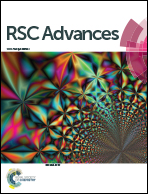Diverting the phase transition behaviour of adipic acid via mesoporous silica confinement†
Abstract
Manipulating the phase transition behaviour of phase change materials (PCMs) to a favorable range is an urgent issue which poses a considerable challenge to their widespread application, since PCMs with desirable operational temperatures and high efficiency are very few in practice. An attempt to address this puzzle is presented by confining adipic acid in silica scaffolds through an impregnation method. Three different nanoscale chambers – 2D-hexagonal silicas MCM-41 and SBA-15, and 3D-silica mesoporous foam (MCF) – were employed. In this way, novel form-stable PCMs were developed, which acquired size-dependent thermal behaviour. The evolution of thermal behaviour as a function of pore size was investigated. Phase transition temperature (Tm) deviations presented a strong linear relationship with inverse pore sizes, conforming to the modified Gibbs–Thomson equation. Enthalpy changes (ΔHm) shared the same trend with Tm, as pore sizes decreased, while the variation of phase transition temperatures (ΔTm) was in the opposite direction. Unlike the bulk state, the phase transition temperature of adipic acid in a confined space could be regulated over 90 °C. The maximum thermal storage efficiency was 72% with respect to the confined acid content. Thus, the solid–liquid phase transition behaviour of adipic acid in a confined space could be altered, and the manipulation of thermal behaviour was achieved.



 Please wait while we load your content...
Please wait while we load your content...